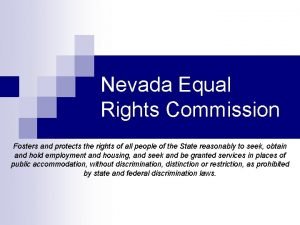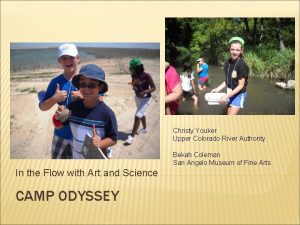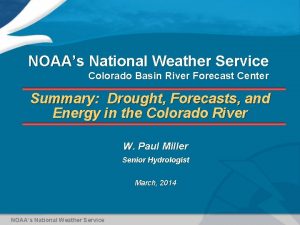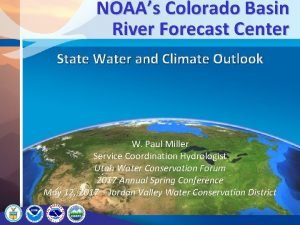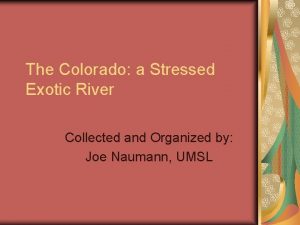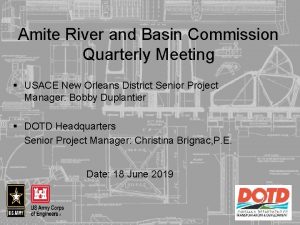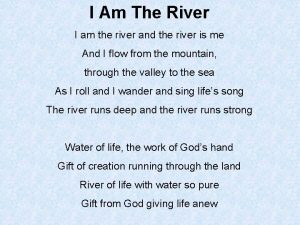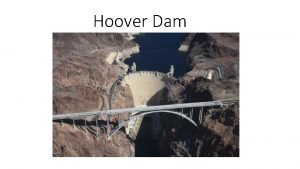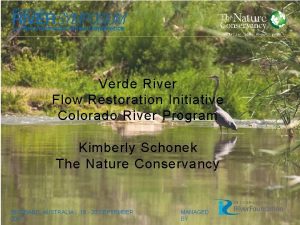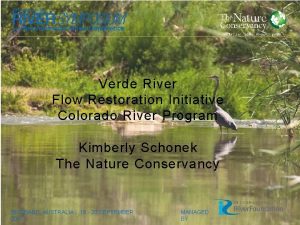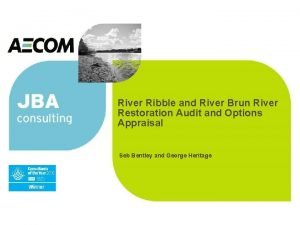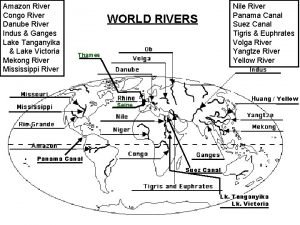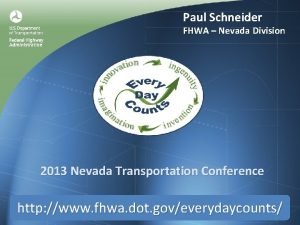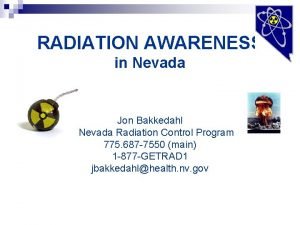Colorado River Commission of Nevada CRCNV The Colorado














- Slides: 14

Colorado River Commission of Nevada (CRCNV) The Colorado River: Collaboration at Work Jayne Harkins, P. E. Executive Director August 18, 2017

Presentation Outline • • • CRCNV Overview Nevada Colorado River Water Use Third Drinking Water Intake at Lake Mead – Purpose – Funding • Lower Basin Drought Contingency Plan – Overview – Contributions – Response • Colorado River reaching Sea of Cortez in May, 2014 (Peter Mc. Bride) Questions 8/18/2017 2

CRCNV Overview The CRCNV is an executive agency of the State of Nevada responsible for acquiring and managing Nevada's share of water and hydropower resources from the Colorado River. Responsible for protecting the rights and interests to Nevada’s entitlement of water made available from the Colorado River. Purchases hydropower from federal hydroelectric facilities on the Colorado River located at Hoover, Davis, Parker and Glen Canyon dams and allocates the hydropower for the greatest benefit to Nevada. 8/18/2017 Strives to protect the water quality, and the aquatic and terrestrial integrity of the Colorado River Basin while ensuring the continued operation of the Colorado River for the authorized beneficial purposes. 3

Southern Nevada Water Use Facts Rest of the State 31% Population of Nevada Population of 2. 9 M (2016) Nevada GDP $147 B (2016) 0% Rest of the State 37% Southern Nevada 63% Southern Nevada 69% 4 3, 8 3, 6 Visitors to Las Vegas Average 3. 5 million per month 3, 4 3, 2 Millions/month 2016 3 Jan 8/18/2017 Feb Mar Apr May Jun Jul Aug Sep Oct Nov Dec 4

Southern Nevada Water Use Facts Local Groundwater 10% Potable Water Supplies Colorado River 90% Nevada’s annual share of the Colorado River: 300, 000 Acre Feet 8/18/2017 5

Third Drinking Water Intake at Lake Mead Prior to 2016, Lake Mead had only two water intakes: • Both of these would become inactive at 1, 000 foot water elevation • To continue to deliver water to Southern Nevada below 1, 000 feet, a third water intake was constructed Courtesy of the SNWA 8/18/2017 6

Third Drinking Water Intake at Lake Mead The Third Water Intake: • Diverts water at Lake elevations below 1, 000 feet • Minimizes water quality issues associated with drought conditions • Provides long-term protection of Southern Nevada’s drinking water source (Lake Mead) The Third Drinking Water Intake is stainless steel – 96 -feet high, 16 -foot diameter structure 8/18/2017 7

Third Drinking Water Intake at Lake Mead Funding was accomplished through the assessment of various charges to community residents: • Regional Connection charges • Sales Tax • Reliability surcharge • Fixed Capital Investment charge 8/18/2017 8

Water Budget at Lake Mead (measured in million acre feet – “maf*”) • Inflow = 9. 0 maf* (Dependent on operational decisions) • Outflow and consumptive use = -9. 6 Arizona (2. 8) California (4. 4) Nevada (0. 3) Mexico (1. 5) Downstream loses (0. 6) • Lake Mead evaporation losses • Balance = -0. 6 = -1. 2 Given the lower basin consumptive use and evaporative losses, Lake Mead loses on average 4 feet a year with a 9. 0 maf release from Lake Powell and 12+ feet when an 8. 23 maf is released. 8/18/2017 9

Lower Basin Drought Response Activities • Through 2016, four conservation programs have resulted in about 1 maf of additional water in Lake Mead, equivalent to about 12 feet in elevation. – U. S. Intentionally Created Surplus (nearly 3 feet) – Mexican deferred water under IBWC Minute 319 (about 2. 5 feet) – LB Drought MOU voluntary protection volumes (about 6 feet) – Pilot System Conservation Program (about 1 foot) • As of July 2017, planned conservation activities in 2017 are projected to result in another 540 kaf of additional water in Lake Mead, equivalent to about 6. 5 feet in Lake Mead elevation. 8/18/2017 10

Lower Basin Drought Contingency Plan (DCP) • The Lower Basin DCP was developed to address the increasing variability and decline in the Colorado River flow volumes. • To avoid risk of temporary and prolonged interruptions in water service through 2026, the Lower Basin States (Arizona, California, and Nevada) agreed to take additional reductions in supplies above the 2007 Interim Guidelines. • Congressional authority may be required for implementation. 8/18/2017 11

Lower Basin DCP Lower Basin Reductions under the Lower Basin Drought Contingency Plan (volumes in KAF) Lake Mead Elevation (ft msl) 2007 Interim Guidelines Shortages Voluntary Reductions Combined Volumes (2007 Interim Guidelines Shortages + Voluntary Reductions) AZ NV CA Lower Basin States Total 1, 090 - >1, 075 0 0 192 8 0 200 1, 075 - >1050 320 13 192 8 0 512 21 0 533 1, 050 - >1, 045 400 17 192 8 0 592 25 0 617 1, 045 - >1, 040 400 17 240 10 200 640 27 200 867 1, 040 - >1, 035 400 17 240 10 250 640 27 250 917 1, 035 - >1, 030 400 17 240 10 300 640 27 300 967 1, 030 - 1, 025 400 17 240 10 350 640 27 350 1, 017 <1, 025 480 20 240 10 350 720 30 350 1, 100 8/18/2017 12

Summary • Lake Mead is declining due to drought and imbalances in supply and demand. • Current projections show the 2007 Interim Guidelines are not sufficient to address the declines. • Nevada and the other Lower Basin states have invested efforts to protect Lake Mead. • More action is needed and occurring to address continuing risks to Lake Mead. 8/18/2017 13

JAYNE HARKINS, P. E. Executive Director (702) 486 -2670 COLORADO RIVER COMMISSION OF NEVADA 555 EAST WASHINGTON AVE. , Suite 3100 LAS VEGAS, NV 89101 CRCNV Website: crc. nv. gov 8/18/2017 14
 Kara jenkins nevada
Kara jenkins nevada Marie earns an 8 commission for selling appliances
Marie earns an 8 commission for selling appliances Defects of mudaliar commission
Defects of mudaliar commission Lennard high school football
Lennard high school football Upper colorado river authority
Upper colorado river authority Colorado river basin forecast center
Colorado river basin forecast center Colorado river forecast
Colorado river forecast Colorado basin river forecast center
Colorado basin river forecast center Is the colorado river an exotic stream
Is the colorado river an exotic stream Amite river basin commission
Amite river basin commission Green river (duwamish river tributary)
Green river (duwamish river tributary) I am the river and the river is me
I am the river and the river is me Thẻ vin
Thẻ vin Thơ thất ngôn tứ tuyệt đường luật
Thơ thất ngôn tứ tuyệt đường luật Bàn tay mà dây bẩn
Bàn tay mà dây bẩn
